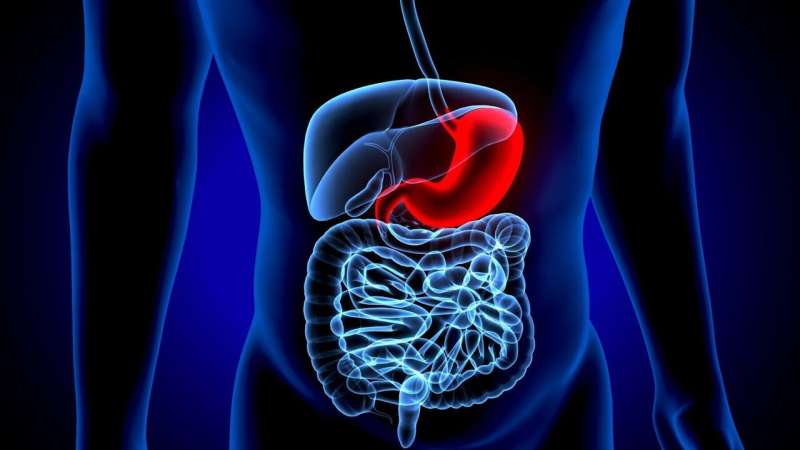This article has been reviewed according to Science X's editorial process and policies. Editors have highlighted the following attributes while ensuring the content's credibility:
fact-checked
reputable news agency
proofread
Findings from studies presented at Digestive Disease Week

Digestive Disease Week, the annual meeting sponsored by the American Association for the Study of Liver Diseases, American Gastroenterological Association, American Society for Gastrointestinal Endoscopy, and Society for Surgery of the Alimentary Tract, was held from May 18 to 21 in Washington, D.C., drawing more than 13,000 participants from around the world, including researchers and academics in the fields of gastroenterology, hepatology, endoscopy, and gastrointestinal surgery.
In one study, Yazan Abboud, M.D., of the Rutgers University New Jersey Medical School in Newark, and colleagues found that non-Hispanic Black patients have been experiencing an increase in the incidence of gallbladder cancer.
In a nationwide analysis covering nearly 98 percent of the U.S. population, Abboud and colleagues evaluated the medical records of 76,873 patients diagnosed with gallbladder cancer between 2001 and 2020 using the U.S. Cancer Statistics database.
The researchers found that minority patients of non-Hispanic Black race/ethnicity experienced an increase in gallbladder cancer incidence, on average, between 2001 and 2020 compared with other race/ethnic groups, who experienced a decline in incidence. In addition, many of the cases involved tumors diagnosed at an advanced stage.
"These findings help in understanding the epidemiology of gallbladder cancer and aim to guide future efforts to identify the contributions of the revealed racial/ethnic disparity," Abboud said.
In another study, Christopher McGowan, M.D., of True You Weight Loss in Cary, North Carolina, and colleagues found that endoscopic mucosal ablation of the gastric fundus is safe and effective and produces a statistically and clinically meaningful reduction in ghrelin, hunger, meal capacity, and weight.
In a six-month registered clinical trial, the authors aimed to determine whether it would be feasible to endoscopically ablate the lining of the gastric fundus to reduce ghrelin hormone production, gastric capacity, and weight. Ten patients underwent outpatient endoscopic ablation of their fundus lining, a procedure that took approximately one hour to complete under anesthesia. All patients went home the same day.
Six months after the procedure, the researchers found that patients had a significant reduction in plasma ghrelin levels (45 percent lower), meal capacity (42 percent smaller), hunger, appetite, and cravings. Patients also had increased confidence to resist overeating.
The average patient lost 7.7 percent of their body weight, with half of the patients losing 10 percent or more of their body weight. There were no serious adverse events reported.
"This technique may represent a future treatment path for patients with obesity, particularly those who do not want surgery, those who do not want or aren't able to use medications, and those who desire to reduce hunger directly," McGowan said. "This is a promising new technology that warrants further study but has the potential to join the growing list of safe, effective obesity treatments."
Chris Thompson, M.D., of Brigham and Women's Hospital in Boston, and colleagues found that endoscopists are exposed to dangerous levels of ultrafine particles, particulate matter ≤2.5 μm, and volatile organic compounds during multiple smoke-generating procedures.
The authors measured air particles and air quality during 27 endoscopic procedures, including argon plasma coagulation, gastric and colonic endoscopic submucosal dissection, and ampullary sphincterotomy.
The researchers found that procedures differed in the number of particles they produced. Gastric argon plasma coagulation produced higher levels of particulate matter ≤2.5 μm and ultrafine particles than other procedures. Levels of volatile organic compounds, a marker for indoor air quality, reached twice the maximum safety level determined the Environmental Protection Agency.
"Over a career, endoscopic smoke may pose significant health risks not just to endoscopists, but all personnel in the endoscopy suite. Further work is needed to better characterize and mitigate this threat," Thompson said. "Surgeons in the operating room have guidelines to mitigate smoke exposure, but that does not exist in gastrointestinal endoscopy. As we learn more about this potential threat, we will need to adopt new practices to protect endoscopy personnel."
DDW: 1999 to 2020 saw rise in incidence of colorectal cancer in people under 45
For individuals aged younger than 45 years, the incidence of colorectal cancer increased considerably from 1999 to 2020, with a 333 percent increase among those aged 15 to 19 years, according to another study presented at 2024 Digestive Disease Week.
More information:
Press Release
Press Release
Press Release
Read Full Text
Copyright © 2024 HealthDay. All rights reserved.




















